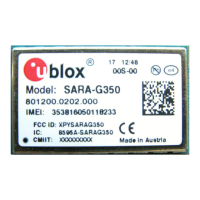SARA-G3 and SARA-U2 series - System Integration Manual
UBX-13000995 - R26 System description
Page 61 of 217
SARA-G3 and SARA-U2 series modules’ auxiliary UART interface can be configured in AT command mode by
means of the AT+USIO command (for more details, see Table 12 and Table 13), so that:
the cellular module waits for AT command instructions and interprets all the characters received over the
auxiliary UART interface as commands to execute
the auxiliary UART interface provides RS-232 functionality conforming to the ITU-T V.24 Recommendation
(more details available in ITU Recommendation [10]), with CMOS compatible signal levels: 0 V for low data
bit or ON state, and 1.8 V for high data bit or OFF state (for detailed electrical characteristics see the
SARA-G3 series Data Sheet [1] and the SARA-U2 series Data Sheet [2])
the cellular module is designed to operate as a modem, which represents the Data Circuit-terminating
Equipment (DCE) according to ITU-T V.24 Recommendation [10]: the application processor connected to the
module through the auxiliary UART interface represents the Data Terminal Equipment (DTE)
Software flow control and None flow control can be set (see the u-blox AT Commands Manual [3], &K,
+IFC, \Q AT commands), with default setting None flow control
1200, 2400, 4800, 9600, 19200, 38400, 57600, 115200, 230400, 460800 and 921600 bit/s baud rates can
be set (see the u-blox AT Commands Manual [3], +IPR)
8N1, 8N2, 8E1, 8O1, 7E1 or 7O1 frame format can be set (see the u-blox AT Commands Manual [3], +ICF)
The signal names of SARA-G3 series modules’ auxiliary UART interface conform to the ITU-T V.24
Recommendation [10]: e.g. the TXD_AUX line represents the data transmitted by the DTE (application
processor data line output) and received by the DCE (module data line input).
Hardware flow control is not supported on the auxiliary UART interface.
1200, 230400, 460800 and 921600 bit/s baud rates are not supported by SARA-G3 modules on the
auxiliary UART interface.
SARA-G3 modules do not support automatic baud rate detection (autobauding) and automatic frame
recognition on the auxiliary UART interface: 115200 bit/s and 8N1 are the default setting.
SARA-U2 modules support the one-shot automatic baud rate detection (one-shot autobauding) and the
one-shot automatic frame recognition, which are the default setting. The baud rate and frame automatic
detection is performed only once, at module start-up. After the detection, the module works at the
detected baud rate and frame format, and then they can only be changed by AT command (see the
u-blox AT Commands Manual [3], +IPR and +ICF command).
Data mode and Online command mode are not supported over the Auxiliary UART interface, so that for example
the ATD command for data call, the ATO command for online data state resuming, the AT+CGDATA command
for data state entering and the AT+USODL command for direct link are not supported, but Mobile Originated
voice call can be accepted, Mobile Terminated voice call can be triggered and voice call hang-up can be done
over the auxiliary UART interface.
The auxiliary UART interface provides only data output and input signals, so that for example the AT&C, AT&D
and AT&S commands have no effect on the interface, since there are no DCD, DTR and DSR lines available.
When the auxiliary UART interface is configured in AT command mode by means of the AT+USIO command (for
more details, see Table 12, Table 13 and the u-blox AT Commands Manual [3]), then both the UART and the
auxiliary UART interfaces can receive AT commands in parallel. The UART can be used for AT commands, data
communication and Multiplexer functionalities, while auxiliary UART can be used for AT commands only.
See the “Multiple AT command interfaces” appendix in the u-blox AT Commands Manual [3], for further details
regarding multiple AT command interfaces general usage and related AT command profile configurations.
The power saving configuration is controlled by the AT+UPSV command, which can be retrieved over the
auxiliary UART interface as over the UART interface: it sets the module power saving configuration and also the
interface behavior in relation to the power saving. For further details regarding power saving configurations, see
section 1.9.1.4 and the u-blox AT Commands Manual [3], +UPSV AT command.

